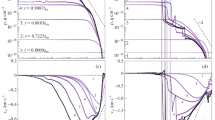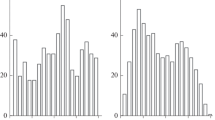Abstract
We simulate the formation of the Oort cloud (OC) till the age of 2 Gyr starting from an initial disc of planetesimals made by 10 038 test particles. The results on the outer part of the distant comet reservoir are reported by Neslušan et al. (this issue). Here we deal with the evolution of the population and structure at 2 Gyr of the complementary inner part of the Oort cloud. The dynamical evolution of the massless test particles was followed via the numerical integration of their orbits. We considered the perturbations produced by four giant planets assuming they have their current orbits and masses, as well as the perturbations caused by the Galactic tide and passing stars. The efficiency of the formation of inner OC is found to be very low: only about 1.1% of all considered particles ended in this part of the OC. At 2 Gyr, the dynamics of the inner cloud is mainly governed by the dominant z-term of the Galactic tide. The number density of the bodies is proportional to the heliocentric distance, r, as r −3.53. The directional distribution of orbits is still strongly inhomogeneous. There are large empty regions in the space angles around the Galactic Equator points with the galactic longitude 90 and 270° (non-rotating frame), or there are only few bodies having the ecliptical latitude higher than +60° or lower than 60°. A strong concentration of objects at the Ecliptic is apparent up to ≈1,000 AU, with a possible—but still not proved—extension to ≈1,500 AU. Beyond r ≈ 6,000 AU, bodies directly above and below the Sun, with respect to the Ecliptic, are absent.
Similar content being viewed by others
Avoid common mistakes on your manuscript.
1 Introduction
This work is based on a simulation of the formation of the Oort cloud and describes the evolution till 2 Gyr of the so called inner OC. The simulation starts after the giant planet are formed. The Proto-Planetary Disc (PPD) is composed of ∼10,000 massless test particles (TPs), and evolves under the perturbations due to giant planets, Galactic-tide and stellar close encounters. The inner OC as been hypothezed from the analyses of the properties of the dynamically new comets. Tracing their dynamical properties back in time along the last perihelion passage researchers noticed that the original (before entering the planetary region) semi-major axes of new comets were not shorter than a typical lower limit a c . That limit was assumed as a dividing border between the so called inner and outer part of the OC. In the real Solar System, the comet cloud probably does not have such discontinuity and, most likely, it continually extends inward. The limit we actually experience is probably due to our limited observational capability. An introduction to the work and the complementary results on the outer part of the distant comet reservoir are reported by Neslušan et al. 2009 (this issue). Detailed description of the model and the full discussion of the results can be found in Dybczyński et al. 2008 and Leto et al. 2008, 2007.
2 Results
In the following we classify a given TP as a member of the inner OC if its perihelion distance is q ≥ 50 AU and its semi-major axis is 2,000 < a ≤ a c , where we adopt a c = 25,000 AU, see Leto et al. 2008 for a detailed discussion on this definition.
2.1 Population Evolution
The left plot in Fig. 1 shows the evolution of the inner OC population along the time. During the first mega-year the inner-OC population quickly rises due to the ejections of TPs from the Jupiter-Saturn region, after reaching a very early maximum, it steeply decreases. Few mega-years after the beginning, it again increases till the maximum at about 1250 Myr. From this time, the erosion of the inner OC dominates over an increase of its population.
According to our simulation and definitions of the inner and outer OC, the formation efficiency of the inner OC is 1.1%. At 2 Gyr 90% of the TPs residing in the OC are in the Inner OC, 10% in the outer OC.
2.2 Population Origins
The TPs distributions versus time for different originating regions of the PPD are shown in Fig. 1 (right). Some consideration can be made: (a) The initial increase is due to Jupiter and Saturn regions TPs, (b) after ≈500 Myr the number of the TPs originating in the EKB region appears to be larger than each of the amounts from the Jupiter and Saturn regions, and clearly exceeds these amounts at 2 Gyr, (c) the largest amounts of Inner-OC TPs originate from the Uranus and Neptune regions, and (d) from 1.250 to 2 Gyr the inner-OC population slowly decreases
The composition of the Inner-OC population at 2 Gyr results as follows: 4% TPs from Jupiter region (4–8 AU), 6% from Saturn region (8–15 AU), 35.5% from Uranus region (15–24 AU), 35.5% from Neptune region (24–35 AU), and 19% from Kuiper-belt region (35–50 AU). A large number of TPs into the inner-OC are moved from the initial heliocentric distance 35–37 AU region that is the 4:3 mean-motion resonance with Neptune.
2.3 Radial Structure Evolution
At the end of the simulation the distribution of TPs in inner-OC is centrally concentrated, and the number density of the TPs residing in the OC in the interval 5,000 < r < 100,000 AU can be fitted by the power law with the index of slope s = −3.529, see Fig. 2.
2.4 Flatness at 2 Gyr
The orbits in the innermost part of inner OC have a low inclination to the Ecliptic as expected, inclinations larger than 45° occur for a ≥ 4,000 AU. TPs belonging to the central region of the Inner-OC, at least for r ≤ 1,000 AU are located in a disc shaped region near the Ecliptic (see Fig. 3). Beyond this distance, more TPs are situated at a larger distance from the Ecliptic.
Our 2 Gyr results describe an interesting evolution scenario but cannot be extrapolated to the current inner OC as the evolution seems to be in a quasi steady-state only during the final short period, the extrapolation up to 4.5 Gyr can be an over-interpretation at this stage of the computation (see Leto et al., 2008, Sect. 2.4). Further simulations are already ongoing.
References
P. A. Dybczyński, G. Leto, M. Jakubík, T. Paulech, L. Neslušan, The simulation of the outer Oort cloud formation - The first giga-year of the evolution. A&A 487, 345–355 (2008)
G. Leto, M. Jakubík, T. Paulech, L. Neslušan, PA. Dybczyński, The structure of the inner Oort cloud from the simulation of its formation for two Giga-years. MNRAS 391 1350–1358 (2008)
G. Leto, M. Jakubík, L. Neslušan, P.A. Dybczyński, T. Paulech, The outer Oort cloud formation: Simulation of the first Gyr evolution, in Proceedings of the Symposium “Grid Open Days all’Universita’ di Palermo”, (Consorzio COMETA, Palermo, Italy, 2007), pp. 53–58 ISBN 978-88-95892-00-9
L. Neslušan, P.A. Dybczyński, G. Leto, M. Jakubík, T. Paulech, 2-Gyr simulation of the Oort-cloud formation, I. Introduction on a new model of the outer Oort-cloud formation. This issue
Acknowledgements
G.L. thanks PI2S2 Project managed by the Consorzio COMETA, http://www.pi2s2.it and http://www.consorzio-cometa.it for the computational resources and technical support. L.N., M.J., and T.P. thank the project “Enabling Grids for E-sciencE II” (http://www.eu-egee.org/) for the provided computational capacity and support in the development of the computer code, which was necessary for the management of tasks on the GRID. They also acknowledge the partial support of this work by VEGA— the Slovak Grant Agency for Science (grants Nos. 7009 and 7047). P.A.D. acknowledges the partial support of this work from Polish Ministry of Science and High Education (year 2008, grant No. N N203 302335).
Author information
Authors and Affiliations
Corresponding author
Rights and permissions
About this article
Cite this article
Leto, G., Jakubík, M., Paulech, T. et al. 2-Gyr Simulation of the Oort-cloud Formation II. A Close View of the Inner Oort cloud after the First Two Giga-years. Earth Moon Planet 105, 263–266 (2009). https://doi.org/10.1007/s11038-009-9297-8
Received:
Accepted:
Published:
Issue Date:
DOI: https://doi.org/10.1007/s11038-009-9297-8







